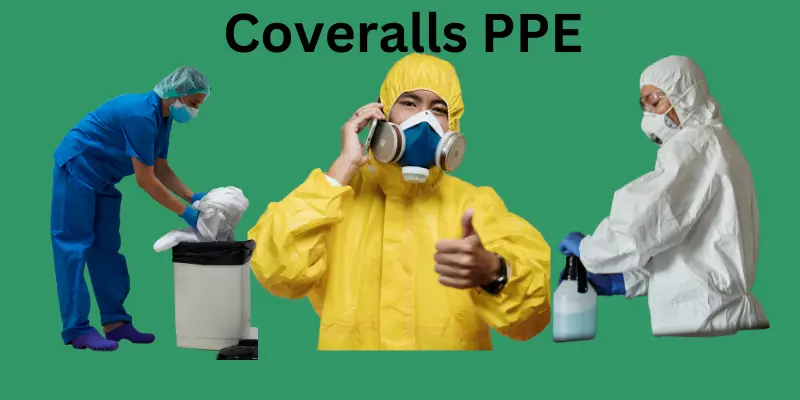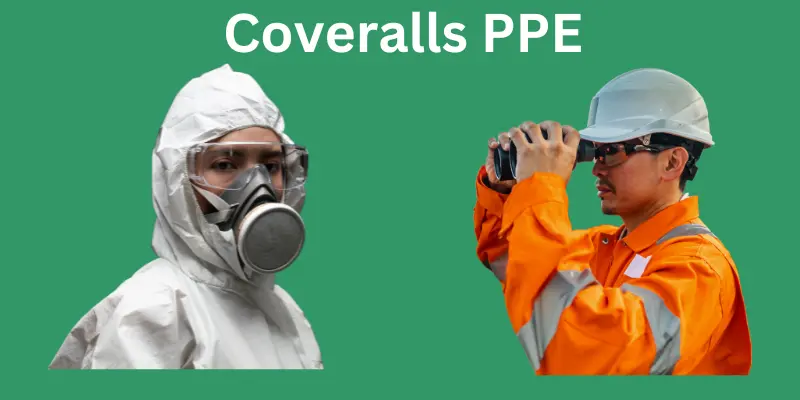TOP 10 Coveralls PPE and Manufacturers: An In-Depth Guide
Updated: 28-Jan-2025
261
Personal protective equipment (PPE) is essential for safeguarding individuals from occupational hazards. Coveralls stand out as a versatile and effective protective garment among the wide range of PPE available. They are designed to provide full-body protection, ensuring safety in diverse industries and environments. This article delves into the details of coveralls, exploring their purpose, types, usage, history, and more.

1. What is Coveralls PPE?
Coveralls PPE refers to one-piece garments that provide full-body coverage, protecting wearers from environmental, chemical, biological, or mechanical hazards. They are designed to cover the torso, arms, legs, and sometimes the head, offering comprehensive protection against contaminants, debris, and harmful substances.
1. Where Are Coveralls PPE Used?
Coveralls PPE is widely used in various industries, including:
- Healthcare: For infection control and biohazard protection.
- Construction: To shield workers from dust, debris, and other hazards.
- Manufacturing: To protect against chemicals, oils, and industrial materials.
- Oil and Gas: For protection against fire, heat, and chemical spills.
- Agriculture: To shield against pesticides and other chemicals.
- Emergency Services: For firefighters and rescue workers facing hazardous environments.
- Aerospace and Aviation: To protect personnel handling sensitive materials.
2. Types of Coveralls PPE
There are several types of coveralls PPE tailored to specific needs:
- Disposable Coveralls: Made from lightweight materials like polypropylene for single-use applications.
- Flame-Resistant Coveralls: Designed to withstand high temperatures and fire hazards.
- Chemical-Resistant Coveralls: Manufactured to protect against chemical splashes and spills.
- Waterproof Coveralls: For wet environments and protection against liquids.
- High-Visibility Coveralls: Equipped with reflective materials for safety in low-light conditions.
- Insulated Coveralls: Designed for cold environments, offering thermal protection.
3. Why Are Coveralls PPE So Important?
Coveralls PPE plays a critical role in ensuring workplace safety by:
- Preventing contamination: Protecting workers from hazardous substances.
- Reducing injury risks: Shielding against sharp objects, heat, and chemicals.
- Enhancing productivity: Providing comfort and flexibility during tasks.
- Ensuring compliance: Meeting industry safety standards and regulations.
2. The History of Coveralls PPE
Coveralls PPE has evolved significantly since its inception:
- Early 20th Century: Used primarily in industrial settings for mechanical protection.
- World War II: Widely adopted by military personnel for chemical and fire protection.
- Post-War Era: Innovations in materials led to lightweight, versatile designs.
- Modern Times: Advanced materials like Tyvek and Nomex enhance functionality and comfort.
1. Benefits of Coveralls PPE
- Full-body protection from various hazards.
- Durability ensures long-term use in demanding environments.
- Comfortable designs enable extended wear.
- Variety of options for different applications.
- Ease of use with simple donning and doffing procedures.
- Hygienic and contamination-free options.
- Reusable and disposable choices to suit different needs.
- Cost-effective solutions for workplace safety.
- Lightweight materials for mobility.
- Enhanced visibility with reflective designs.
2. Usage of Coveralls PPE: Past, Present, and Future
- Past: Primarily used in industrial and military applications.
- Present: Widespread use across healthcare, construction, and other industries.
- Future: Advanced materials and smart technologies, such as integrated sensors for real-time hazard monitoring.
3. Material Used in Manufacturing Coveralls PPE
Coveralls PPE is made from various materials, including:
- Polypropylene: Lightweight and cost-effective for disposable coveralls.
- Polyester: Durable and resistant to wear and tear.
- Cotton: Breathable and comfortable for general use.
- Tyvek: High resistance to chemicals and particles.
- Nomex: Flame-resistant material for high-risk environments.
- PVC and Polyurethane: For waterproof and chemical-resistant designs.
4. Coveralls PPE Comparison with Other Types of PPE
| Feature | Coveralls PPE | Aprons & Gowns | Overalls |
|---|---|---|---|
| Coverage | Full-body | Partial (torso) | Torso and legs |
| Protection Level | High | Moderate | Moderate |
| Application | Versatile | Specific tasks | General workwear |
| Durability | High | Varies | High |
| Comfort | Moderate to high | High | High |
5. How to Use Coveralls PPE
- Choose the right type based on the work environment.
- Inspect for damage before use.
- Don the coverall properly, ensuring full coverage.
- Use additional PPE (e.g., gloves, goggles) if required.
- Doff carefully, avoiding contamination.
- Dispose of or clean as per the manufacturer’s instructions.
3. Pros and Cons of Coveralls PPE
1. Pros:
- Comprehensive protection.
- Versatile for various industries.
- Durable and long-lasting.
- Available in reusable and disposable options.
- Lightweight materials improve mobility.
- Resistant to chemicals and hazardous substances.
- Fire-resistant options for high-risk jobs.
- Hygienic and contamination-free use.
- Easy to wear and remove.
- Meets safety regulations.
2. Cons:
- It can be uncomfortable in hot climates.
- Limited breathability in some materials.
- Disposable options may generate waste.
- High-quality designs can be costly.
- Sizing issues may arise.
- Restricted mobility in poorly designed models.
- Limited reusability for certain types.
- Improper use can compromise safety.
- Material degradation over time.
- Not suitable for every hazard.
4. Top 10 “Coveralls PPE” Product Companies
1. DuPont Personal Protection
- Introduction:
DuPont, founded in 1802, is headquartered at 974 Centre Road, Wilmington, DE, USA. The company employs over 28,000 staff globally. It is known for pioneering innovative protective solutions, producing millions of coveralls annually. - Products:
- Tyvek® 400 coveralls
- Tyvek® 500 HV high-visibility coveralls
- Nomex® industrial coveralls
- Tychem® 2000 chemical-resistant coveralls
- Tychem® 6000 protective suits
- Disposable fire-resistant coveralls
- Arc-rated coveralls for electricians
- Lightweight protective coveralls
- Biohazard-resistant coveralls
- Anti-static coveralls
2. Lakeland Industries
- Introduction:
Lakeland Industries, established in 1982, is based at 202 Pride Lane SW, Decatur, AL, USA. With over 1,000 employees, it specializes in industrial protective gear, including coveralls with an annual output exceeding 5 million units. - Products:
- Pyrolon® flame-resistant coveralls
- MicroMax® NS protective coveralls
- ChemMax® 1 chemical-resistant coveralls
- ChemMax® 3 heavy-duty chemical suits
- CleanMax® cleanroom coveralls
- Arc-rated coveralls
- FR rainwear coveralls
- Disposable coveralls for biohazards
- Lightweight general-purpose coveralls
- Radiation-shielding coveralls
3. 3M
- Introduction:
3M, founded in 1902, is headquartered at 3M Center in St. Paul, Minnesota, USA. It employs approximately 92,000 workers globally and focuses on innovation in PPE, including durable, high-performing coveralls. Annual production surpasses 10 million pieces. - Products:
- 3M™ Protective Coveralls 4510
- 3M™ Protective Coveralls 4535
- 3M™ Protective Coveralls 4565
- 3M™ Breathable Laminated Coveralls
- 3M™ FR-treated disposable suits
- Chemical-resistant coveralls
- Dust-proof coveralls
- Reusable protective coveralls
- Anti-static coveralls
- Arc-protective coveralls
4. Ansell Limited
- Introduction:
Based at 111 Melbourne Street, Southbank, VIC, Australia, Ansell was founded in 1899. With 13,000+ staff globally, it specializes in advanced PPE with annual production exceeding 8 million coveralls. - Products:
- AlphaTec® chemical-resistant coveralls
- Microgard® medical coveralls
- AlphaTec® FR coveralls
- Cleanroom coveralls
- Reusable coveralls
- Heavy-duty industrial coveralls
- Food-safe protective suits
- Dustproof coveralls
- Lightweight biohazard suits
- Arc-rated protective coveralls
5. Kimberly-Clark Professional
- Introduction:
Founded in 1872, Kimberly-Clark operates from Irving, TX, USA. With over 42,000 employees, it produces high-quality, disposable coveralls, focusing on safety and comfort. Annual output exceeds 6 million units. - Products:
- KleenGuard® A40 coveralls
- KleenGuard® A50 breathable suits
- Disposable microporous coveralls
- Food-safe protective suits
- Medical-grade coveralls
- Cleanroom coveralls
- Anti-static protective suits
- Lightweight general-use coveralls
- Chemical-resistant disposable suits
- Dust-repellent coveralls
6. Honeywell Safety Products
- Introduction:
Honeywell, headquartered at 300 S Tryon St., Charlotte, NC, USA, was founded in 1906. Employing 99,000+ staff worldwide, it produces advanced safety coveralls with annual production exceeding 7 million units. - Products:
- Honeywell North Gen Coveralls
- Disposable chemical-resistant suits
- Arc-rated safety coveralls
- FR-treated lightweight coveralls
- Industrial cleanroom suits
- Biohazard-resistant coveralls
- Waterproof PPE coveralls
- Heat-resistant coveralls
- Dustproof coveralls
- General-purpose protective suits
7. Bulwark FR
- Introduction:
Located at 545 Marriott Dr, Nashville, TN, USA, Bulwark FR specializes in flame-resistant protective gear. Founded in 1971, the company employs over 2,000 staff and produces 3 million coveralls annually. - Products:
- FR heavyweight coveralls
- Hi-visibility FR coveralls
- Lightweight flame-resistant coveralls
- Arc flash coveralls
- Chemical-resistant FR suits
- Welding safety suits
- Electrical protective coveralls
- Oil & gas workwear coveralls
- High-durability FR coveralls
- Disposable fire-retardant suits
8. Portwest
- Introduction:
Portwest, established in 1904, is headquartered at IDA Business & Technology Park, Westport, Ireland. With over 5,000 employees, the company produces millions of coveralls annually for global markets. - Products:
- BizTex® disposable coveralls
- BizWeld® flame-resistant coveralls
- Waterproof PPE coveralls
- Anti-static suits
- High-visibility safety coveralls
- Lightweight disposable suits
- Oil-resistant protective suits
- Industrial chemical coveralls
- FR-treated durable suits
- General-purpose protective coveralls
9. MSA Safety
- Introduction:
MSA Safety, founded in 1914, operates from Cranberry Township, PA, USA. With over 5,000 employees, it specializes in innovative safety equipment, producing 2.5 million coveralls annually. - Products:
- Fire-resistant safety coveralls
- Arc-protective suits
- Biohazard-resistant PPE
- Chemical splash coveralls
- Dustproof safety suits
- Lightweight protective suits
- Oil-resistant coveralls
- Waterproof coveralls
- Reusable flame-retardant suits
- High-visibility safety coveralls
10. Arco
- Introduction:
Based at 6 Queen St., Hull, England, Arco was founded in 1884. Employing 1,600+ staff, it is one of Europe’s largest PPE manufacturers, producing over 2 million coveralls yearly. - Products:
- Disposable microporous suits
- Hi-vis waterproof coveralls
- Flame-retardant welding coveralls
- Anti-static protective suits
- Food-safe coveralls
- Oil-resistant PPE suits
- General-purpose lightweight coveralls
- Chemical-resistant coveralls
- Reusable fire-retardant suits
- Biohazard-proof PPE

5. Standards for Purchasing Coveralls PPE
- ISO 13688: General requirements for protective clothing.
- ISO 16602: Chemical protective suits.
- NFPA 2112: Flame-resistant protective gear.
- EN 14126: Biological protection standards.
- ANSI/ISEA 107: High-visibility gear.
Best and Cheapest Recommendations
- Best: DuPont Tyvek® 400 Coveralls (high durability and lightweight).
- Cheapest: Portwest BizTex® Coveralls (Affordable with essential protection).
Replacement Duration for Coveralls PPE
- Disposable Coveralls: After single use or contamination.
- Reusable Coveralls: After 50 washes or visible wear/damage.
Summary on Coveralls PPE
Coveralls of PPE are essential for ensuring worker safety in hazardous environments and protecting against chemicals, fire, biohazards, and particulates. They comply with stringent standards to ensure effectiveness, durability, and comfort. Industries like healthcare, construction, and oil & gas rely heavily on these garments for workplace safety.
6. FAQs about Coveralls PPE
- What is the difference between coveralls and overalls? Coveralls provide full-body coverage, while overalls cover only the torso and legs.
- Are coveralls PPE reusable? Some are reusable, while others are designed for single use.
- Can coveralls protect against COVID-19? Yes, certain disposable coveralls are effective for infection control.
- What materials are best for flame-resistant coveralls? Nomex and treated cotton are ideal for fire hazards.
- Do coveralls come in different sizes? Yes, they are available in various sizes to fit different body types.
- How should I clean reusable coveralls? Follow the manufacturer’s cleaning guidelines.
- Are coveralls waterproof? Some designs are waterproof, depending on the material used.
- What is the lifespan of coveralls PPE? It varies based on material, usage, and care.
- Can I wear coveralls over regular clothes? Yes, they are typically designed to fit over clothing.
- Where can I buy coveralls PPE? They are available at safety equipment suppliers, online retailers, and specialized stores.
7. Conclusion
Coveralls PPE is a cornerstone of workplace safety, offering full-body protection across various industries. From their historical evolution to modern innovations, coveralls have proven their indispensability. By understanding their types, applications, and proper usage, industries can ensure optimal safety for their workforce. Whether for construction, healthcare, or emergency services, investing in high-quality coveralls PPE is a step toward a safer, more secure work environment.
Please Write Your Comments